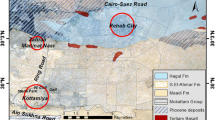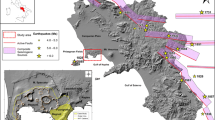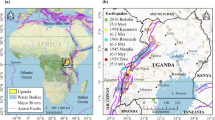Abstract
While the Southeast China region is situated in an intraplate area of low to moderate seismicity, it has experienced several noticeable earthquakes including the 1918 Shantou Earthquake having a magnitude of 7.3. This paper describes a rigorous probabilistic seismic hazard model for Southeast China using Hong Kong as a case study. Due to the scarcity of instrumental records of strong motion earthquakes, there are no appropriate ground motion predictive equations that can be derived from observed data. A number of the recently developed stochastic simulations of the seismological models have been appraised to quantify the seismic hazard as accurately as possible in order that future structures can be appropriately designed. As part of performing the hazard assessment, a detailed catalogue of historical and recent earthquakes within the Southeast China region has been compiled with data updated to 2009. A new seismic source model has also been developed based on consideration of observed seismicity, geological and tectonic information, and the source zone boundaries that were used to produce seismic hazard maps in the current Chinese code for seismic design of buildings, GB50011 (2010). The effect of the size of the seismic source zone is discussed. The results of the study include uniform seismic hazard spectra at the location of Hong Kong city and hazard maps for the surrounding part of Southeast China.

















Similar content being viewed by others
References
Abrahamson N, Silva W (2007) NGA ground motion relations for the geometric mean horizontal component of peak and spectral ground motion parameters. Final Report prepared for the Pacific Earthquake Engineering Research Center, USA
Arup (2012) Final report on overall seismic hazard assessment. Landslip prevention and mitigation programme, pilot seismic microzonation study in north-west New Territories for the study of potential effect of earthquake on natural terrain—investigation, agreement no. CE49/2008(GE). Final report prepared for the Geotechnical Engineering Office, Government of the Hong Kong SAR
Atkinson GM (1993) Source spectra for earthquakes in eastern North America. Bull Seismol Soc Am 83:1778–1798
Atkinson GM, Boore DM (1997) Model of strong motions from earthquakes in central and eastern North America: best estimates and uncertainties. Seismol Res Lett 68(1):41–57
Atkinson GM, Boore DM (2006) Earthquake ground-motion prediction equations for eastern North America. Bull Seismol Soc Am 96(6):2181–2205
Boore DM, Atkinson GM (2007) NGA ground motion relations for the geometric mean horizontal component of peak and spectral ground motion parameters. Final report prepared for the Pacific Earthquake Engineering Research Center, USA
Boore DM, Joyner W (1993) Estimation of response spectra and peak accelerations from western North American earthquakes: an interim report. Open file report 93-509, United States Geological Survey
Campbell KW, Bozorgnia Y (2007) NGA ground motion relations for the geometric mean horizontal component of peak and spectral ground motion parameters. Final report prepared for the Pacific Earthquake Engineering Research Center, USA
CEA (1995) The directory of historical strong earthquakes (23rd Century B.C. to 1911 A.D.). Department of Earthquake Disaster Prevention, China Earthquake Administration, Seismic Publisher, China (in Chinese)
CEA (1999) The directory of recent earthquakes in China (1912 A.D. to 1900 A.D.). Department of Earthquake Disaster Prevention, China Earthquake Administration, Science Publisher, China (in Chinese)
CEA (2005) The directory of strong earthquakes in China (23rd Century B.C. to June 2005 A.D.). Bureau of Monitoring and Prediction, Science Publisher, China (in Chinese)
Chandler AM, Lam NTK (2002) Scenario predictions for potential near-field and far-field earthquakes affecting Hong Kong. Soil Dyn Earthq Eng 22:29–46
Chandler AM, Lam NTK, Tsang HH, Sheikh MN (2005) Estimation of near-surface attenuation in bedrock for analysis of intraplate seismic hazard. J Seismol Earthq Eng 7(3):159–173
Chandler AM, Lam NTK, Tsang HH (2006a) Near-surface attenuation modelling based on rock sites shear-wave velocity profile. Soil Dyn Earthq Eng 26(11):1004–1014
Chandler AM, Lam NTK, Tsang HH (2006b) Regional and local factors in attenuation modelling: Hong Kong case study. J Asian Earth Sci 27(6):892–906
Chiou SS-J, Youngs RR (2007) PEER-NGA empirical ground motion model for the average horizontal component of peak acceleration and pseudo-spectral acceleration for spectral periods of 0.01 to 10 seconds. Final report prepared for the Pacific Earthquake Engineering Research Centre, USA
Coppersmith KJ, Youngs RR (1986) Capturing uncertainty in probabilistic seismic hazard assessments within intraplate tectonic environments. Proc III US Natl Conf Earthq Eng 1:301–312
Cornell CA (1968) Engineering seismic risk analysis. Bull Seismol Soc Am 58:1583–1606
Ding YZ (2004) Earthquake risk theory of Guangdong and Hong Kong. Commercial Press Hong Kong, Hong Kong (in Chinese)
EAGP (2012) Draft report of seismic source model for the 5th generation of the Chinese code for seismic design of buildings. Earthquake Administration of Guangdong Province (in Chinese)
Free M, Pappin J, Koo R (2004) Seismic hazard assessment in a moderate seismicity region, Hong Kong. In: Proceedings of 13th world conference on earthquake engineering, Vancouver, Canada, paper no. 1659
Gardener JK, Knopoff L (1974) Is the sequence of earthquakes in Southern California, with aftershocks removed, Poissonian? Bull Bull Seismol Soc Am 64(5):1363–1367
GB18306 (2001) Seismic ground motion parameter zonation maps. Peoples Republic of China
GB50011 (2010) Seismic design code for buildings. Peoples Republic of China
GCO (1991) Review of earthquake data for the Hong Kong region, GCO publication no. 1/1991, Geotechnical Control Office, Hong Kong
GEO (2012) Review of earthquake data for the Hong Kong region, GEO publication no. 1/2012, Geotechnical Engineering Office, Hong Kong
Gutenberg B (1945) Magnitude determination for deep focus earthquakes. Bull Seismol Soc Am 35:117–130
Hsieh YS (1957) A new scale of seismic intensity adapted to the conditions in Chinese Territories. Acta Geophys Sin 6:35–47 (in Chinese)
IBC (2009) International building code 2009. International Code Council, CA, USA
Lam NTK, Wilson JL, Hutchinson GL (2000a) Generation of synthetic earthquake accelerograms using seismological modelling: a review. J Earthq Eng 4(3):321–354
Lam NTK, Wilson JL, Chandler AM, Hutchinson GL (2000b) Response spectral relationships for rock sites derived from the component attenuation model. Earthq Eng Struct Dyn 29:1457–1489
Lam NTK, Venkatesan S, Wilson JL, Asten MW, Roberts J, Chandler AM, Tsang HH (2006) Generic approach for modelling earthquake hazard. Adv Struct Eng 9(1):67–82
Lee CF, Ding YZ, Huang RH, Yu YB, Guo GA, Chen PL, Huang XH (1998) Seismic hazard analysis of the Hong Kong region. (GEO report no. 65). Geotechnical Engineering Office, Hong Kong
Mak S, Chan LS, Chandler AM, Koo RCH (2004) Coda Q estimates in the Hong Kong region. J Asian Earth Sci 24:127–136
McGuire RK (1993) Computations of seismic hazard. In: Giardini, D, Basham, PW (eds) Global seismic hazard assessment Program, Annali di Geofisica, vol 34, pp 181–200
Oasys (2008) User manual of Oasys SISMIC for seismic hazard analysis
Pubellier M, Chan LS (2006) Morphotectonic Map of Cenozoic structures of South China-Northern Vietnam coastal region (with CD-ROM and explanatory text). Hong Kong University, Department of Earth Science, Hong Kong
Pun WK, Ambraseys NN (1992) Earthquake data review and seismic hazard analysis for the Hong Kong region. Earthq Eng Struct Dyn 21:433–443
Sewell RJ, Campbell SDG, Fletcher CJN, Lai KW, Kirk PA (2000) The pre-quaternary geology of Hong Kong. Hong Kong Geological Survey, Geotechnical Engineering Office, Hong Kong
Tam CM, Leung YK, Pun WK, Fletcher CJN, Wilde PW (1997) The new Hong Kong digital seismic monitoring network. Hong Kong Geol 3:1–6
Tsang HH (2006) Probabilistic seismic hazard assessment: direct amplitude-based approach. Ph.D. thesis, Department of Civil Engineering, University of Hong Kong
Tsang HH, Chandler AM (2006) Site-specific probabilistic seismic-hazard assessment: direct amplitude-based approach. Bull Seismol Soc Am 96(2):392–403
Weichert DH (1980) Estimation of the earthquake recurrence parameters for unequal observation periods for different magnitudes. Bull Seismol Soc Am 70(4):1337–1346
Wells DL, Coppersmith KJ (1994) New empirical relationships among magnitude, rupture length, rupture width, rupture area, and surface displacement. Bull Seismol Soc Am 84(4):974–1002
Yu YX (2005) The study of seismic hazard assessment for structural seismic design—attenuation relationships. The Institute of Geophysics, China Earthquake Administration, China
Acknowledgments
The authors express a gratitude to Dr Tim Mote from Arup for his time to comment on this paper. This paper is published with the permission of the Head of Geotechnical Engineering Office and the Director of Civil Engineering and Development, Hong Kong SAR Government.
Author information
Authors and Affiliations
Corresponding author
Rights and permissions
About this article
Cite this article
Pappin, J.W., Koo, R.C.H., Jiang, H. et al. A rigorous probabilistic seismic hazard model for Southeast China: a case study of Hong Kong. Bull Earthquake Eng 13, 3597–3623 (2015). https://doi.org/10.1007/s10518-015-9798-y
Received:
Accepted:
Published:
Issue Date:
DOI: https://doi.org/10.1007/s10518-015-9798-y




